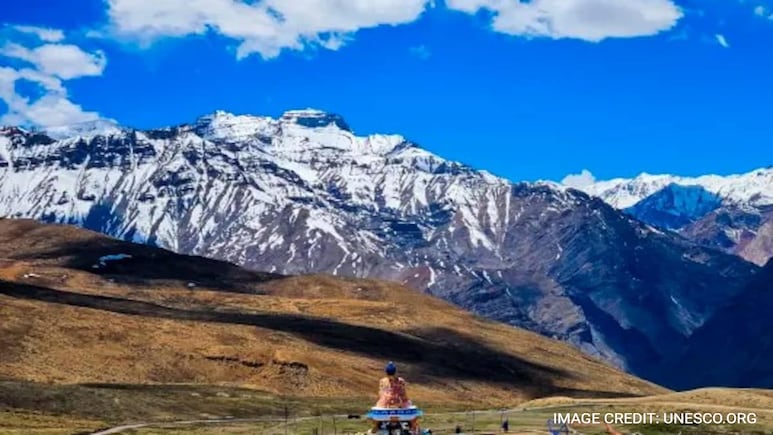
India's Cold Desert Biosphere Reserve, perched high in the trans-Himalayan region, is among the 26 new biosphere reserves across several countries, designated by UNESCO, the world body announced on Saturday.
With this addition, India now has 13 biospheres listed in UNESCO's World Network of Biosphere Reserves (WNBR).
We're happy to welcome 26 new #BiosphereReserves to @UNESCO's global network! 👏
— UNESCO 🏛️ #Education #Sciences #Culture 🇺🇳 (@UNESCO) September 27, 2025
These unique sites bring together people & nature to find local solutions to global problems.
Learn more about the newest additions: https://t.co/wwmea2P92i pic.twitter.com/n00GfTOy2W
The Cold Desert Biosphere Reserve of northern India spans approximately 7,770 sq km across the dramatic landscapes of Himachal Pradesh's Lahaul-Spiti district, according to UNESCO.
Encompassing windswept plateaus, glacial valleys, alpine lakes, and rugged high-altitude deserts, it is one of the coldest and driest ecosystems in WNBR.
"UNESCO designates 26 new biosphere reserves across 21 countries - the highest number in 20 years. The World Network of Biosphere Reserves now includes 785 sites in 142 countries, with an additional one million sq km of natural areas brought under protection since 2018 - equivalent to the size of Bolivia," the world body said in a statement.
The decision to include India's Cold Desert Biosphere Reserve in the WNBR was taken at the 37th session of UNESCO's International Coordinating Council of the Man and the Biosphere (MAB) held in Paris on Saturday, Union Minister for Environment and Forests Bhupender Yadav said in a post on X.
"With this addition, India now proudly has 13 biospheres listed in UNESCO's World Network of Biosphere Reserves, which reflects India's commitment towards biodiversity conservation and community-led sustainable development," the minister said.
Happy to share that during the 37th Session of the UNESCO's International Coordinating Council - Man and the Biosphere - held today, India's Cold Desert Biosphere Reserve, Himachal Pradesh, has been included in the World Network of Biosphere Reserves.
— Bhupender Yadav (@byadavbjp) September 27, 2025
With this addition, India… pic.twitter.com/wtPOwRyOoM
He said India continues to make dedicated efforts towards preserving, protecting and restoring the ecosystem under the leadership of Prime Minister Narendra Modi.
The development comes soon after two Ramsar sites in India were added to the UNESCO list, increasing the total number of Ramsar sites to 93, Yadav added. Ramsar sites refer to those listed on the List of Wetlands of International Importance.
The UNESCO recognition of the cold desert biosphere is likely to promote tourism and research in the region.
This year, six countries welcomed their first biosphere reserve, while Sao Tome and Principe became the first state to have its entire territory designated as a biosphere reserve, UNESCO said.
Six countries saw the designation of their first biosphere reserve on Saturday: Angola, Djibouti, Equatorial Guinea, Iceland, Oman and Tajikistan, it said.
In addition to these six, new reserves have also been designated in Albania, China, Ethiopia, France, Greece, India, Indonesia, Jordan, Madagascar, Malaysia, Mongolia, Portugal, Saudi Arabia and Sweden, it added.
"With nearly thirty new designations this year, our World Network of Biosphere Reserves has reached a major milestone, now protecting 5 per cent of the planet. Within these reserves, new ways of balancing nature conservation with sustainable livelihoods are being forged every day," UNESCO Director General Audrey Azoulay was quoted as saying in the statement.
"UNESCO will continue to mobilise states, scientists, civil society, and local and Indigenous communities to continue this positive momentum," she said.
This week, UNESCO gathered more than 2,000 international experts, public decision-makers, civil society, Indigenous representatives and youth for the 5th World Congress of Biosphere Reserves, to take stock of the achievements of this historic UNESCO programme, and chart its course for the coming decade.
During the Congress, Audrey Azoulay invited every member state to establish at least one biosphere reserve by 2035, it said.
Biosphere reserves safeguard some of the planet's richest and most fragile ecosystems.
Cold Desert Biosphere Reserve harbours 732 species of vascular plants, including 30 endemics and 157 near-endemics of the Indian Himalayas, according to UNESCO.
Altitudes in this reserve range from 3,300 to 6,600 m, covering the Pin Valley National Park and Kibber and Chandratal Wildlife Sanctuaries, it said.
This fragile cold desert ecosystem supports hardy alpine grasses, medicinal herbs, and rare stands of Willow-leaved sea-buckthorn, Himalayan birch and Persian juniper.
Iconic fauna include the snow leopard, Himalayan ibex, blue sheep, Himalayan wolf, and rich bird life such as the Himalayan snowcock and golden eagle.
Around 12,000 inhabitants live in scattered villages, practising traditional pastoralism, yak and goat herding, barley and pea farming, and Tibetan herbal medicine, knowledge sustained through Buddhist monastic traditions and community councils that regulate the use of fragile alpine resources, it said.
As India's first high-altitude cold desert biosphere reserve, it highlights the urgent need to safeguard mountain ecosystems facing tourism pressures and climate change, UNESCO added.
(Except for the headline, this story has not been edited by NDTV staff and is published from a syndicated feed.)
Track Latest News Live on NDTV.com and get news updates from India and around the world

